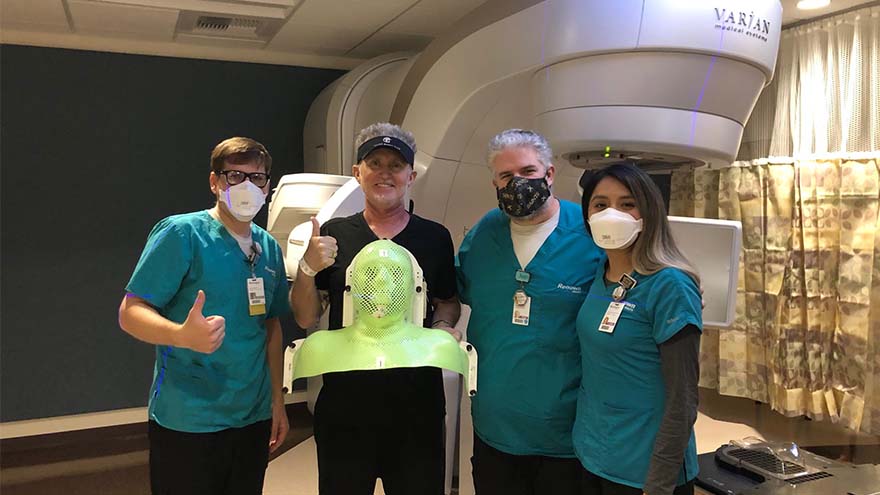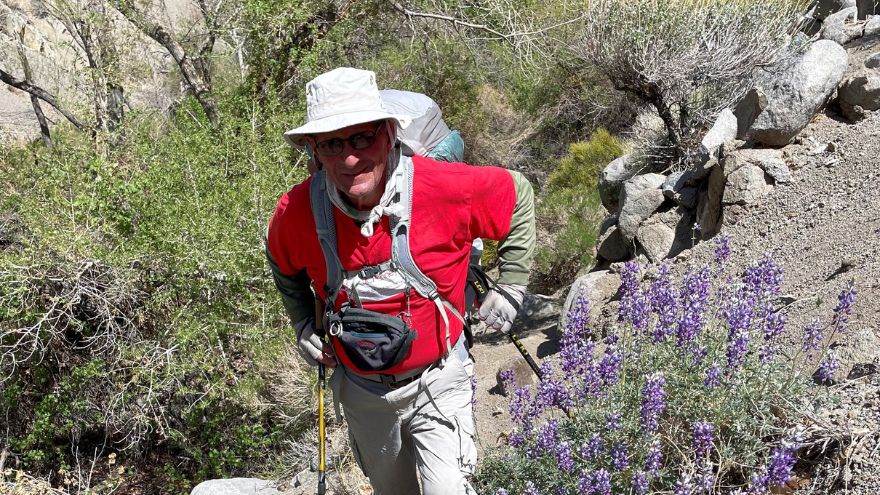Buscar
Results for 'clinic'
Clear-
Un diagnóstico de cáncer y una mudanza a Reno
Michael Millman was all set to move to Reno from the Bay Area when he noticed a pimple-like growth on his forehead, and he decided to get biopsied "just in case." It was July 2020, less than six months into the COVID-19 pandemic, when Michael got the call that the biopsy came back cancerous. He was in shock. Still living in the Bay Area at the time, he immediately scheduled to have the basal cell carcinoma removed in August. After the removal, he thought he was in the clear, but a few months later, Michael noticed that his lymph nodes felt weird, and he even cut himself shaving because of some persistent swelling in the area. Given his recent history of skin cancer, Michael immediately scheduled an appointment with a specialist in the Bay Area. "I met with an ear, nose and throat doctor who suggested a fine needle biopsy of my lymph nodes, tongue and an MRI, both with and without contrast," Michael said. "I remember feeling dreadful and that I couldn't believe this was happening yet again." A Hard Decision Michael's squamous cell carcinoma, determined by the pathology report to be significantly influenced by the HPV virus, had metastasized to his lymph nodes on both sides of his neck, and his doctor said it could be stage four cancer. He remembers feeling like he was in quicksand, unsure if he should follow through with his move to Reno, or stay in the Bay Area for treatment. By now, it was early December 2020, and hospitals in the Bay Area and across the world were at limited capacity due to COVID-19. But, in what Michael describes as a positive twist of fate, the San Francisco ear, nose and throat provider he had seen about his biopsy results mentioned that he knew many providers in the oncology department at Renown, including Abhinand Peddada, MD. The San Francisco provider called Dr. Peddada's office with a referral, and Michael even remembers that Renown called him to hear more about his diagnosis before he even got the chance to call them "To be honest, I was feeling shut out in the Bay Area, and Dr. Peddada said he could help me expedite the treatment process," Michael said. "I finally felt a sense of relief." And so began Michael's 7-week chemoradiation cancer treatment program at Renown.
-
Cinco consejos para mantener la salud mental mientras busca empleo
It is no secret that looking for a new job can be stressful and overwhelming. Yet a record number of Americans are quitting their jobs to look for new opportunities, a trend also known as the “Great Resignation.” While there are many reasons why someone might be on the hunt for new work, it’s important for all job hunters to check in with their mental health regardless of their job hunting circumstances. To learn more about maintaining your mental health while looking for a new job, we spoke to Dr. Mavis Major, a Licensed Clinical Social Worker and Behavioral Health Therapist at Renown Health. 1. Identify Goals When beginning your job-hunting journey, your first step should be to make a plan that focuses on quality over quantity. Make lists of companies you would like to work for and, if you’re looking to change fields or industries, make a list of careers that interest you. At this stage in the process, it’s also important to determine what salary range you’re looking for, what type of work environment you want (in-person, remote or hybrid) and understand what benefits are important to you. Identifying goals makes it easier to narrow down the list of jobs you apply for so you can produce quality applications rather than frantically applying for jobs without putting thought into the process. 2. Set Boundaries It does not matter if you are working full-time while applying for jobs or if applying is your job right now; it can be easy to get lost in the stress of it all. For that reason, it is essential to set intentional boundaries throughout the process. This can look like scheduling days that you fully take off from the job search or going for a walk before a big interview to clear your head. Setting boundaries will make you more productive overall and hopefully help you get your mind off the process. 3. Ask For Help Do not try and tackle this undertaking on your own. Once you have identified goals (see tip #1) make lists of people you know within those industries, and do not be afraid to reach out. Of course, never be afraid to reach out to a mental health professional to talk through why this process might be making you feel anxious. Talking to someone who is not your friend or family can give you a different perspective.
Read More About Five Tips for Maintaining Your Mental Health While Job Hunting
-
Young and Resilient Fighters: Advanced Childhood Cancer Treatment Close to Home
Austin was five years old when he was diagnosed with leukemia. A fever and pale looking skin prompted his mom, Brenda, to bring him into his primary care physician in Carson City. After doing some blood work, the fight to beat Austin's cancer began. The initial shock of learning your child has cancer is traumatic and can feel like a whirlwind. Then the questions begin – will my child survive, what happens next, how will we tell his siblings, will we have to travel out of state for quality care? The list of questions feel endless. While grappling with the news, Brenda brought Austin to Renown Children’s Hospital for an additional check-up. This weeklong hospitalization started with a series of tests to confirm Austin’s diagnosis and ultimately it led to treatment for the leukemia. Dr. Jacob Zucker, a pediatric oncologist at Renown Children's Hospital, was with Austin every step of the way, even meeting him in the parking garage on his first day of treatment. Brenda is eternally grateful that Dr. Zucker was on staff at Renown Children's Hospital, which allowed them to keep Austin's care in Reno. The alternative was to travel out of state for care. "Dr. Zucker was the best thing to ever happen to our family. I consider him a part of our family now," said Brenda. "His kindness and knowledge gave us faith in him." Treatment for Childhood Leukemia Austin’s treatment was broken into a number of stages with the first eight months of therapy being the hardest. He would receive almost weekly therapy at Renown Children’s Infusion Center as well as frequent spinal taps with chemotherapy. After eight months, and for the next three years, Austin would receive a maintenance phase therapy. This meant oral chemotherapy every day, IV chemotherapy once a month, spinal chemotherapy every three months and steroids for the first five days of every month. After more than four years of fighting cancer, Austin, now 10, is free of any disease. Currently, he has blood work every two months to ensure he is on the right track. Seeking Advice from Children’s Oncology Groups Throughout Austin's treatment, Brenda regularly sought advice from Children's Oncology Group (COG) members. COG is the world’s largest organization devoted exclusively to childhood cancer. Renown Children's was not a member of COG at the time of Austin's treatment -- with the closest facilities located in the Bay Area and Salt Lake City – but it is /now. “When faced with pediatric cancer, the last thing parents should worry about is traveling great lengths to receive the best in cancer care," said Larry Duncan, Vice President of Pediatrics and Surgery and Administrator at Renown Children's Hospital. "We are proud to now offer the most advanced childhood cancer treatment options here at Renown, close to home and convenient for area patients and their families.” This membership allows Renown to enroll our youngest patients – just like Austin – in the latest clinical trials, including groundbreaking treatments, studies to understand these diseases better and in addition, this program will focus on supportive care and survivorship. "The COG allows Renown providers to access treatment plans that were not available to non-COG hospitals when Austin was receiving treatment," said Brenda. "It comforts me to know that not only can children receive cancer treatment right at home, but their parents can now elect for them to participate in trials and plans that are at the forefront of cancer treatment today." How You Can Help Make a Difference Renown Health is focused on being the destination for all your family’s health and healthcare needs. As a not-for-profit health system, Renown relies heavily on community funding. If you are interested in supporting Renown Health, and kids like Austin, please consider giving to Renown Health Foundation. Donations are accepted through the following ways: Make a gift at www.renown.org/give Call Renown Health Foundation at 775-982-5545 Mail a check to Renown Health Foundation, 1155 Mill St., 02, Reno, NV 89502
Read More About Young and Resilient Fighters: Advanced Childhood Cancer Treatment Close to Home
-
Hiking Through Life After TAVR
Renown Health patient, Alden Nash, hiking Death Valley National Park just three months after a Transcatheter Aortic Valve Replacement. Alden Nash isn’t your average 80-year-old. For much of his life, he could be found outdoors enjoying nature and hiking some of the west coast’s highest elevations. A husband and father of two, Alden turned his passion into a career as a Yellowstone park ranger in 1965. Alden believes his passion for the outdoors is responsible for his many years of health – until the unavoidable happened. The Hardest Climb The number one doctor recommendation for a healthy heart – lead a healthy, active lifestyle. Any cardiologist would be thrilled to have Alden as a patient due to his robust physical activity regimen. “Don’t have a TV set or a lounge chair in your house and you’re all set,” said Alden when asked how he has remained so fit throughout his senior years. Unfortunately, many other factors come into play when it comes to heart health, one of which is the reason we are telling Alden’s story today. Familial history - it’s a hot topic in the world of medicine. Understanding your genetic risk factors can help care providers develop updated care plans based on your results. Alden’s family has a long history of high cholesterol, which he avoided for much of his life by staying active. This combined with his age resulted in his first heart attack in December 2021. Doctors later determined that Alden was suffering from a type of heart valve disease known as aortic valve stenosis. Aortic stenosis is the narrowing of your aortic valve opening that impedes normal blood flow. Over time, the leaflets of your aortic valve become stiff, reducing their ability to fully open and close. When the leaflets don’t fully open, your heart must work harder to push blood through the aortic valve of your body. Eventually, your heart gets weaker, increasing the risk of heart failure. People who are most at risk for aortic stenosis include those who have had certain heart conditions present at birth, have chronic kidney disease or have heart disease risk factors such as high cholesterol and high blood pressure. However, generally, aortic stenosis is a degenerative process of aging with no modifiable risk factors. The incidence of aortic stenosis increases rapidly with age and is very common above the age of 80 – with 1/10 having the condition and 1/50 with a problem severe enough to warrant surgery. When symptoms are present, the disease can be rapidly disabling or even deadly, often progressing over several months unless treated.



